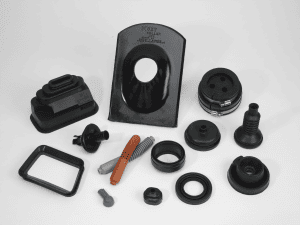Rubber Terminology
As an engineering material, elastomers offer elasticity and flexibility, toughness which provides wear, cut and abrasion resistance, physical strength, relative impermeability to liquids and gases, and oil and fuel resistance.
An evaluation of physical properties of a given elastomer should be made in a specific compound under specific application conditions. However, as a general guide to comparative properties, material producers and rubber compounders can supply data based on “typical” recipes or compounds in standard tests.
Hardness
Hardness is determined by measuring the extent to which surface resists indentation by a standard indenter. It is an important property which has a relationship to modulus and tensile strength. Measurements are commonly made by Shore Durometer.
Tensile Properties
Tensile strength, in Mega pascals (pounds per square inch), measures the load per unit area of the original cross section to cause rupture. Elongation measures rubber strength. It expresses, by percent, the amount of increase over initial length at instant of rupture. Modulus, in Mega Pascals (pounds per square inch), is a measure of loading required to stretch a test specimen a standard amount, usually 100 to 300%.
Compression Set
A measure of the degree to which a test specimen under standard loading and time “sets,” deforms, or does not rebound to original dimensions. Expressed in percentage. Important in sealing applications, particularly for high pressures over extended periods.
High Temperature Performance
Measures effect heat has on properties of rubber compound. Particularly important for automotive applications where performance at elevated temperature is increasingly important.
Fluid Resistance Properties
Elastomers are generally classified as non-oil-resistant, general-purpose polymers or oil-resistant, specialty polymers. General purpose, higher volume polymers are lower cost with broad use in tires and treads. The oil-resistant rubbers, particularly nitrile, find specialized use in a large number of engineering applications where fuel and oil resistance are important.
Low Temperature Characteristics
Flexibility is the property most adversely affected by low temperatures. Lowering temperature results in loss of resilience, increased hardness, and finally brittleness. The brittle point is determined not only by the temperature and nature of the rubber, but also by its rate of deformation. Hardness, hysteresis, Joule-effect, flex cracking, modulus, elongation, tensile strength, and permanent set are also temperature dependent.
Safety
We also use industrial vacuums to keep our manufacturing facility clean and safe.






